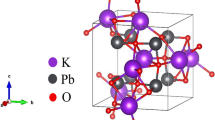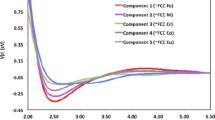Abstract
Self-consistent cellular multiple scattering techniques and photoemission energy distribution curves obtained at 20<hv<80 eV are used to study the density of states of UN and US. The calculations are based on a model using a finite cluster of atoms in a condensed-matter-like boundary potential. The main results refer to the mixing of thes, p, d, andf-states of uranium into a valence and a conduction band. Thef-states form orbitals with the ligands, within the valence and conduction bands. In the nitride the amount off character in the valence band is only 0.3 electrons and thef electrons are in two resonant levels (of each spin) in the conduction band. Only the first of these levels is occupied for the local, alternate from atom to atom, majority spin. In the sulfide the amount off character in the valence band is 0.59 electrons and the rest of thef-levels are in a resonance state (of majority spin) at the beginning of the conduction band. The conduction band is mainly of localized uranium 6d character. The theoretical results compare favorably with the photoemission data reported here.
Similar content being viewed by others
References
Erbudak, M., Eib, W.: Helv. Phys. Acta50, 147 (1977)
Keller, J.: Proc. III. Int. Conf. Computers in Chemical Research, Education and Technology, p. 225, Ludeña, E.V., Sabelli, N., Wahl, A.C. (eds.). New York (1977)
Eastman, D.E., Freeouf, J., Erbudak, M.: J. Physique C6, 37 (1973)
Keller, J.: J. Phys. C4, 3143 (1971) and J. Physique C3, 241 (1972)
Keller, J., Fritz, J., Garritz, A.: J. Physique C4, 379 (1974) and Keller, J.: AIP Conf. Proc.10, 514 (1973)
Eyges, L.: Phys. Rev.111, 683 (1958)
Herman, F., van Dyke, J.P., Ortenburger, I.B.: Phys. Rev. Lett.22, 807 (1969)
Gunnarsson, O.: J. Phys. F6, 587 (1976)
Keller, J.: In: Int. Topical Meeting on Muon Spin Rotation, Rorschach (1978) and Hyperfine Interactions, to be published
Weinberger, P.: Berichte der Bunsen-Gesellschaft81, 804 (1977)
Eastman, D.E., Kuznietz, M.: Phys. Rev. Lett.26, 846 (1971) and J. Appl. Phys.42, 1396 (1971)
Eib, W., Erbudak, M., Greuter, F., Reihl, B.: J. Physique, in print
Freeman, A.J., Koelling, D.D.: Physica B86, 16 (1977)
Davis, H.L.: The Actinides: Electronic Structure and Related Properties, vol. 2, p. 1, Freeman, A.J., Darby, Jr., J.B. (eds.). New York: Academic Press 1974
Adachi, H., Imoto, S.: J. Nucl. Sci. Technol.6, 371 (1969)
Eib, W., Erbudak, M., Greuter, F., Mattenberger, K., Reihl, B.: Helv. Phys. Acta,51, 458 (1978)
Sattler, K., Siegmann, H.C.: Phys. Rev. Lett.29, 1565 (1972)
Author information
Authors and Affiliations
Rights and permissions
About this article
Cite this article
Erbudak, M., Keller, J. Electronic structure of cubic uranium compounds. Z Physik B 32, 281–286 (1979). https://doi.org/10.1007/BF01351505
Received:
Revised:
Issue Date:
DOI: https://doi.org/10.1007/BF01351505




